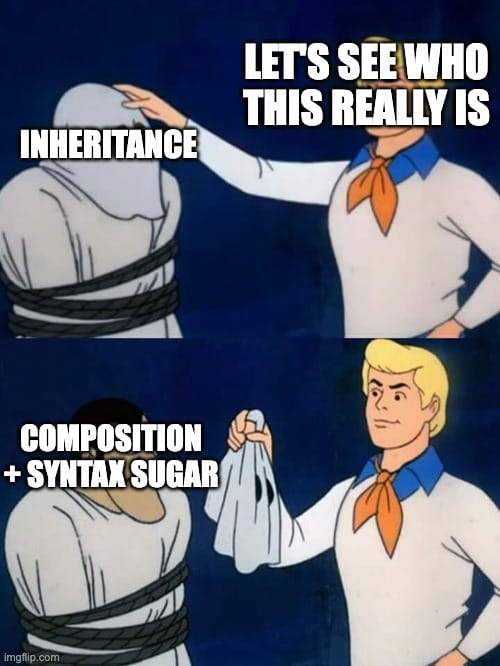Bizarro inheritance
What is inheritance in object orientation really? Intuitively, we tend to think of it as an "is a"-relationship. A car is a vehicle. A house is a building. A dog is an animal.
But from a programming language perspective, the way it works can be expressed in a different way — as "has a" + fancy syntax. There might be no real advantage to seeing things from this perspective, but I find it interesting so I thought I'd share it.
Classic inheritance with classes
Let's look at the car/vehicle relationship and turn it on its head. Traditionally, you'd express it like this (Pretend we don't need initialisers):
class Vehicle {
var numberOfPassengers: UInt
}
class Car: Vehicle {
var numberOfWheels: UInt
}This lets us create a car and access its properties, as well as its parent's properties:
let car = Car()
print(car.numberOfWheels) // Property defined for `Car`
print(car.numberOfPassengers) // Property defined for `Vehicle`Inverted: composition with structs
Now, let's change it to a has a relationship. While we're at it, let's change the classes to structs, because we're basically dropping down to a lower level of abstraction.
struct Vehicle {
var numberOfPassengers: UInt
}
struct Car {
var vehicle: Vehicle
var numberOfWheels: UInt
}Instead of inheriting from Vehicle, our Car type is now composed of a vehicle plus its own fields. To access the parent's fields, we now need to be more explicit:
let car = Car(...)
print(car.numberOfWheels) // We can still access a Car's properties directly
print(car.vehicle.numberOfPassengers) // But we need to access Vehicle's properties through the composition propertyMaking composition feel like inheritance
We can make this setup work more like inheritance by providing getters:
extension Car {
var numberOfPassengers: UInt {
get { vehicle.numberOfPassengers }
set { vehicle.numberOfPassnegers = newValue }
}
}And we can add some standardisation by introducing protocols:
protocol IsVehicle {
var numberOfPassengers: UInt { get set }
}
struct Vehicle: IsVehicle {
// ... this stays the same
}
struct Car: IsVehicle {
var vehicle: Vehicle
var numberOfPassengers {
get { ... } // this is as above
set { ... }
}
var numberOfWheels: UInt
}And we could make things more convenient with default protocol implementations:
protocol HasVehicle {
var vehicle: Vehicle { get set }
}
extension HasVehicle: IsVehicle {
var numberOfPassengers {
get { vehicle.numberOfPassengers }
set { vehicle.numberOfPassengers = newValue }
}
}I think the last part is the most interesting. It shows us that
- If we provide some boilerplate default plumbing, HasVehicle and IsVehicle are equivalent
- This means that
composition + nice syntax ≈ inheritance - You can implement an inheritance relationship from scratch using basic language tools
- OO languages basically just give you syntax to achieve this implicitly rather than explicitly

Of course, it's not quite so simple, but hey!
Multiple inheritance
This also gives us a different perspective to think about the limits of traditional inheritance. Many OO languages forbid multiple inheritance; the argument is that if there is a conflicting field, which parent class is it derived from? But using composition as a stand-in for inheritance, especially if we eschew all the protocol niceness, we can easily have "multiple inheritance", and disambiguate conflicting parent properties by just referencing the parent explicitly. As in:
struct FillableShape {
func draw() { ... }
}
struct OutlineShape {
func draw() { ... }
}
struct MyShape {
var fillable: FillableShape
var outline: OutlineShape
}
// We can specify which `draw` to use
MyShape(...).fillable.draw()
MyShape(...).outline.draw()
// Or we can define what `draw` means for MyShape
extension MyShape {
func draw() {
fillable.draw()
outline.draw()
}
}This is similar to how the Protocol Witness pattern gives us a lower level, more explicit way to think about protocols. Language features like inheritance and protocol conformance help us write less code, but sacrifices some customisation by opting for sensible default implementations. We can always go down to a lower level and make things explicit.